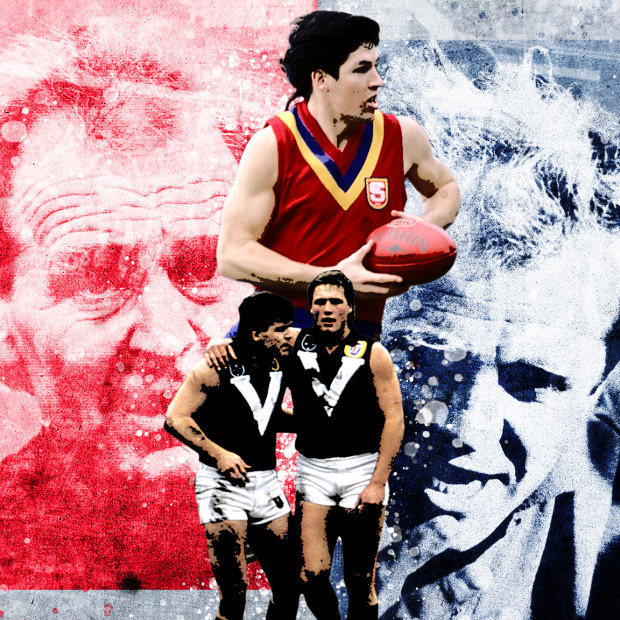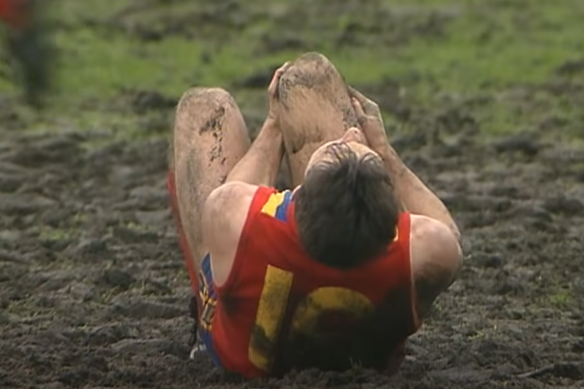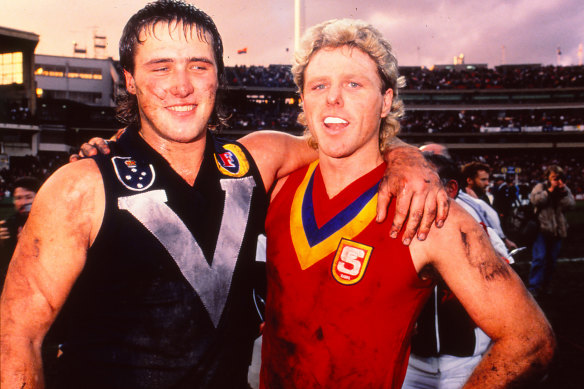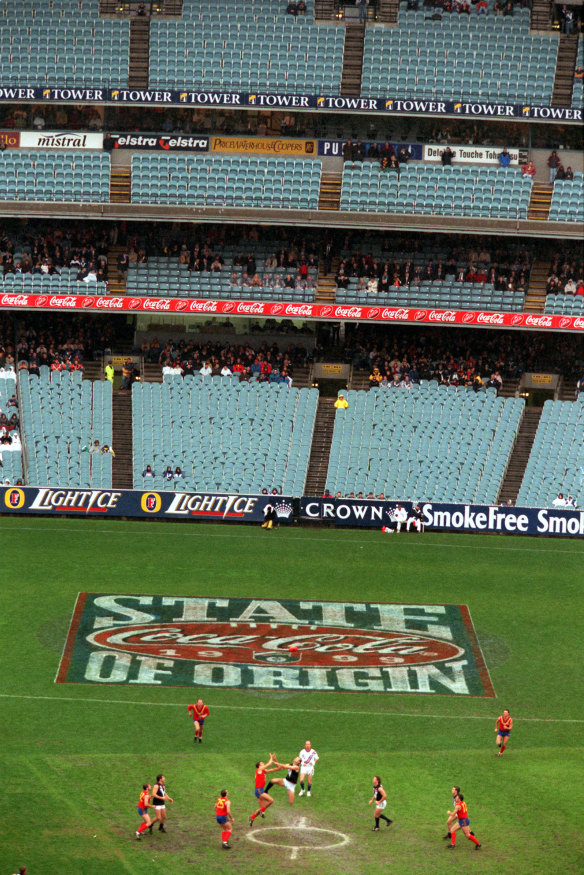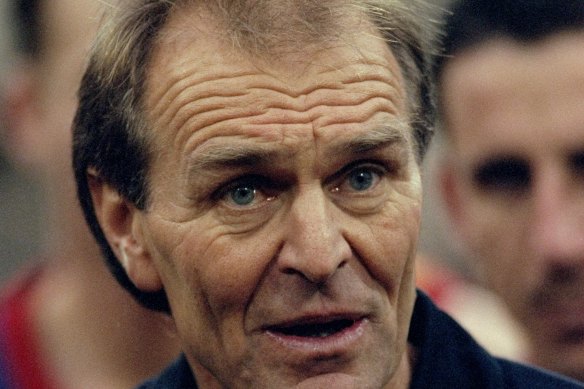They were ‘the greatest games on earth’. So why did State of Origin die?
By Jon Pierik and Andrew Wu
Credit: The Age/Richard Giliberto
Save articles for later
Add articles to your saved list and come back to them any time.
When Andy Collins ran down his Hawthorn teammate Tony Hall at the MCG in 1989, he could not have known his desperate, goal-saving tackle would lead to the demise of State of Origin football.
A crowd of 91,960 had flocked to the MCG to watch Victoria play South Australia for the first time at the venue in 18 years.
It was there that Hall, caked in mud, lay clutching his knee as the stretcher came out. It was an ordinary tackle with traumatic consequences. Had it not happened on a particularly boggy section of the ground, Hall may have walked away from it.
Instead, he was carried off in agony after rupturing three of the four major ligaments in his right knee.
Tony Hall clutches his knee after being injured in a tackle during the 1989 State of Origin clash at the MCG.Credit: Channel Seven
“If you never played in a grand final, State of Origin was the closest thing to it,” Hall told the Crows in 2015.
“Andy was shattered. He was in the hospital with me that night and was really upset about it. He was a good mate, and I still see Andy every now and again these days. It was really tough. The ground was terrible and muddy. You don’t get grounds like that any more, it was horrendous.”
A great decade of state football culminated on that memorable Saturday afternoon in July when the Vics, with loose eligibility criteria, fielded a forward line featuring Tony Lockett, the Brisbane-born-and-raised Jason Dunstall, and Dermott Brereton.
Ten years later, State of Origin as we knew it was gone.
‘Nerves, insecurity, fear … give way to courage and bravery’
At this time of year many AFL fans lament what might have been as they tune into rugby league’s State of Origin series between NSW and Queensland, typically three of the most watched programs of the year.
Referred to as Australian sport’s greatest rivalry, Origin in the northern states is a big deal. Performances at club level are scrutinised from the point of view of worthiness for a Blues or Maroons jersey. The best 36 players in the country come together in combat across 80 bone-jarring minutes playing for a prize considered by some to be greater than the NRL premiership.
The three games last season were the fourth, fifth and sixth most watched programs of the year, with audiences of between 2.529 million and 2.632 million. Only Ash Barty’s Australian Open victory and presentation and the AFL grand final had a larger audience. The NRL grand final was ninth.
NSW great Phil “Gus” Gould used to deliver a stirring call to arms in a pre-game speech on Nine’s telecast titled “Last Word”, outlining the gladiatorial nature of origin.
“Nerves, insecurity, fear, it will give way to courage and bravery. It will give way to the commitment you have to your teammates and your state. It will give way to the commitment you have to do whatever is necessary to win.
“Why? Because that’s what Origin players do.”
Legendary South Australian coach Graham Cornes recalls a time when pulling on a state jumper carried the same honour for Australian rules players – and the punters cared. He also remembers when it changed.
“When the Crows came in, it changed the landscape a bit, but even the ’94 State of Origin game, some people say it’s the greatest game of footy ever played,” Cornes, who won nine of 11 origin matches, including six of eight against Victoria, said.
“Don Scott was one of the commentators. He said at the end it was the best game of footy he had ever seen.”
Simon Madden remembers the pressure he felt when he walked into the Victorian rooms before a game.
“You have got Gerard Healy, Brownlow medallist, Greg Williams, Brownlow medallist, [Dale] ‘Flea’ Weightman, one of the best rovers,” Madden said. “I remember thinking: ‘I have no excuses here, I better do my job. I can’t blame anyone else’.”
Tony Lockett and Dermott Brereton after the win over South Australia in 1989.Credit: Getty Images
‘The two mullets on a Tuesday night’
Former players reminisce about playing for their club on the weekend and backing up for their state on Tuesday before lining up again for their club a few days later.
“Even when I played, they still played [Stephen] Kernahan versus [Paul] Roos, the two mullets, on a Tuesday night,” Saints coach and former Fitzroy hard man Ross Lyon said.
“Timmy Watson going head-to-head with the ‘Rat’ [John] Platten. Some great footy was played, and Teddy Whitten. I think we all loved it. As a kid I went in 1977, the Victorian team with Robert Flower and [Paul] Van der Haar, and they dominated Western Australia, it was great.”
Anthony Koutoufides was devastated when he was ruled out of what would have been his State of Origin debut for Victoria in 1996.
“I got picked to play, but the last week before the game, I got a cork in my calf and it flared up,” he said.
The Carlton great still believes the injury may have been held against him come selection a year later, and it wasn’t until 1999 that he was handed the chance to don the Big V against South Australia in what he viewed as “the greatest games on earth”.
“In the ’80s, I could not wait to watch Vic v SA, Vic, WA. I would rush home from school – the greatest game on earth is on,” Koutoufides said.
Much to Koutoufides’ disappointment, that clash on a sodden MCG proved to be his first – and only – taste of State of Origin.
The AFL signed a four-year deal in 1998 to play the Irish in a post-season International Rules series, and began prioritising that idea instead.
The match between Victoria and South Australia in 1999 would be the final game of state football until a one-off game in 2008 and the bushfire appeal match in 2020.
The one-time pinnacle of the sport that enthralled fans through the semi-professional era of the 1980s and early ’90s had run out of puff.
The beginning of the end
To understand how State of Origin withered in the ’90s, consider how the Hall-Collins incident would be received today. Hall, a high-class forward for Hawthorn, missed the Hawks’ premiership in 1989.
Imagine the blowback if Zach Tuohy ended Jeremy Cameron’s season? Or the anguish of Melbourne fans should Max Gawn hurt his knee in a ruck clash with Brodie Grundy?
“My coach and teammates were very wise, we all rationalised it and moved on,” Collins said. “The unfortunate thing was Tony had an injury that was to keep him out of football for 12 months – that’s the sadness of the incident.
“It could’ve happened on the training track and in a game.
“It’s probably less likely to occur with a field full of good players and decision-makers and good execution.”
Hall’s injury heralded an era when players were more reluctant to play for their states.
In 1999 Victorian coach Robert Walls and chairman of selectors Gerard Healy had to do a roll call after a host of selections had pulled out, either through injury or what some felt was a lack of interest.
A sparse crowd watched Victoria take on South Australia at the MCG in 1999.Credit: Sebastian Costanzo
A decade after 91,960 filling the MCG for the bumper ’89 clash, only 26,063 turned up to watch Victoria take on South Australia on a miserable Saturday afternoon in May.
Former Fitzroy and Sydney great Roos, a regular in the Big V, remembers the knowing looks and chats behind the scenes.
“Perhaps the conversations were taking place between the club doctor and a player, or a coach and a player,” Roos said from Hawaii, where he now lives.
“We were all sceptical as players if you saw someone walk into state training and walk out who didn’t look injured but suddenly weren’t playing.
“We sort of understood it. It wasn’t that controversial, that’s probably why it died a natural death. ”
Roos understands better than most how injuries can hurt clubs. The then Fitzroy captain missed four games to a broken jaw sustained in a state game in 1993. The Roys won just one game to drop out of finals contention. The previous year they lost spearhead Richard Osborne, who had booted 39 goals in eight games, for four matches to a fractured cheekbone.
“It is a big loss to teams when you do lose players, there’s no question about that,” Roos said.
“[But] when I broke my jaw at the MCG against SA, there wasn’t one bit of me that regretted playing. I wasn’t missing the next four weeks saying: ‘I wish I hadn’t played’.”
The competition goes national
The peak of Australian rules State of Origin came in the days of the VFL, before West Coast and then Adelaide entered the league and effectively made every week a state game.
Former West Coast star Karl Langdon still holds a guernsey from the 76-point thumping of Victoria at the WACA in 1991. But it’s not his own jumper from that day.
“I played the last game we beat Victoria in, in ’91 at the WACA. I have got Paul Roos’ jumper to prove it,” he said.
That win came with 14 Eagles in the squad, at a time when they were on the cusp of three grand finals in four years.
While this was a famous win, it may have hastened the drop in interest of home crowds, for there was little difference between the Eagles and the state side.
The top-of-the-ladder Eagles then dropped four of their final 10 matches to lose the grand final to Hawthorn, leading to a change of emphasis under Eagles and WA coach Mick Malthouse the next year. While more than a dozen Eagles were still in the team that lost at the MCG, several players spent time on the bench in the final term. Priorities had shifted.
‘It probably cost me my coaching career’
Cornes, the Crows’ inaugural coach, never feared losing anyone to injury. But he believed the emotional and physical toll of state games hurt the Crows.
South Australia coach Graham Cornes in 1999.Credit: Getty Images
“It probably cost me my coaching career with the Crows, when I look back,” Cornes said.
“In ’94, we had won four out of the first six games, we picked I think 11 Crows players in that state game which was played mid-week, which we won. But, if you look at the graph, we struggled after that, whether it was injuries or guys who had so much [football].
“I look at that but I wouldn’t change because state footy was so important to us.”
Said Roos: “Suddenly you had West Coast and Adelaide come in, which was largely made up of players who would have typically gone to Melbourne and played State of Origin. The relevance stopped because every week you had State of Origin – West Coast v Carlton, Adelaide v Essendon.”
Geelong great Joel Selwood played in the 2008 match as a 19-year-old. He says the increased “professionalism of clubland” meant State of Origin was squeezed out as players became “investments”. Selwood, now working in a leadership role with the Melbourne Storm, says he is jealous when the NRL’s annual origin series rolls around.
“I had one chance of playing State of Origin back in 2008. I was a 19-year-old, and it probably didn’t justify where State of Origin was the decades before that,” Selwood told Maroons coach Billy Slater in an interview aired on Nine.
“So, when it got to an All Star versus Victoria, it probably didn’t have that click as much. So, I am a little bit jealous of what we see out there. But then when I saw game three last year, the first three minutes [of injuries], I think the investment of being a 34-year-old at the same time, and going: ‘Geez, I am glad I’m not putting my body out there’.”
‘We stuck it right up ’em’
No one embodied State of Origin more than Ted Whitten, Victoria’s longtime chairman of selectors whose catchphrase “we stuck it right up ’em” is fondly remembered by older generations.
Many of the 64,186 who watched Victoria play South Australia in 1995 had lumps in their throats as the man known as Mr Football bid farewell to the fans while in the final stages of his battle with prostate cancer.
Whitten, the 321-game Footscray legend and Victorian hero, died two months later and without its spiritual frontman state football was gone within five years.
Check back on Tuesday for part two of our series, on the future of State of Origin. See our potential teams and vote on which would win.
Keep up to date with the best AFL coverage in the country. Sign up for the Real Footy newsletter.
Most Viewed in Sport
Source: Read Full Article
